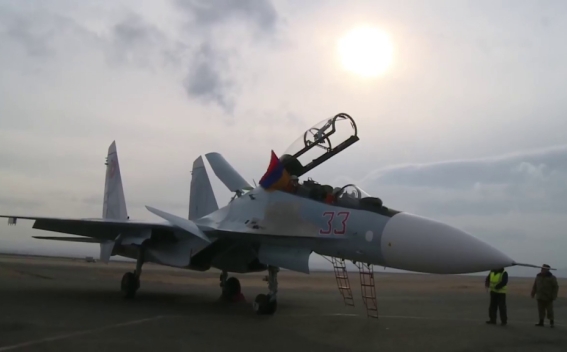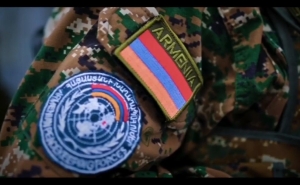India is an ideal candidate for upgrading Armenian Su-30 fighters: Forbes

Rumor has it that Armenia is "keen" on having India supply weapons and train fighter pilots for its Russian-built Su-30SM Flanker fighter jets. While no such arrangement has been confirmed, New Delhi could certainly improve these Armenian aircraft markedly. But is that really a priority for Yerevan? Paul Eden writes about this in his article for Forbes.
India has an enormous fleet of 272 Su-30MKI Flankers, most of them built by New Delhi under license. Aside from operating such a large number of these fighters for 20 years, India has also acquired and developed formidable non-Russian armaments for them.
"What makes the Indian Su-30MKI different from the Flankers operated across the world is that it is a beautiful integration of various weapons, sensors, and avionics from all over the world," an ace Indian fighter pilot told local media in January.
These missiles notably include an air-launched version of the indigenous BrahMos supersonic cruise missile, giving the Su-30MKI a substantive standoff capability, and the Astra beyond-visual-range air-to-air missile (BRAAM).
Defense ties between India and Armenia have noticeably increased in recent months. Yerevan became the first foreign customer for the Indian-built Pinaka multiple-launch rocket system (MLRS) when it ordered four batteries for an estimated $250 million in 2022. Furthermore, the two countries are concerned about growing trilateral military ties between Turkey, Azerbaijan, and Pakistan. Therefore, it would make sense if they cooperate to improve Armenia's Su-30 fleet.
On the other hand, Yerevan may have reservations about investing more in these aircraft.
Armenia acquired four Su-30SMs in 2019. The government of Nikol Pashinyan extolled the purchase of the modern fighter aircraft, proclaiming that the country was finally moving on from the days of shopping around for cheap, low-tech second-hand Soviet-era systems. His optimism proved fatally premature. Armenian Flankers remained idle throughout the 2020 Nagorno-Karabakh conflict against Azerbaijan since they lacked crucial armaments, particularly guided air-to-surface munitions. Sending those sleek jets into combat with unguided rockets would undoubtedly have resulted in losses with little to no discernible gain on the battlefield.
Azerbaijan destroyed several Armenian air defense systems using Israeli-built Harop loitering munitions during that war. Baku's successful use of such weaponry strongly indicated that Yerevan made a fatal blunder by spending so much of its limited military budget on a handful of flashy Flankers at the direct expense of its nascent drone industry. "White Elephant" became the derisory nickname critics used to describe these jets.
Armenia initially hoped to acquire at least a dozen Su-30SMs. It's unclear if it will push ahead with procuring another eight in light of this experience. On the other hand, selling its existing four back to Russia would most likely prove untenable in light of the Russian invasion of Ukraine. Yerevan already denied rumors last March that it had transferred its Flankers back to Moscow for use in that war.
Furthermore, any Armenian acquisition of additional Su-30s could spur Azerbaijan to respond by acquiring modern fighters. Baku could well use an Armenian procurement, which Yerevan can ill afford, as an excuse to finally acquire the JF-17 Thunder fighter jointly developed by China and Pakistan, which it has had its eye on for years. A dozen JF-17 Block 3 fighters armed with Chinese PL-15 BVRAAM would hugely improve Azerbaijani airpower and likely negate any advantage more Flankers would provide Armenia.
Yerevan may, therefore, settle for something in the middle. It could request Indian expertise and systems to improve the four Flankers it already has so they could become somewhat useful in the event of another war with Azerbaijan, which remains a possibility.
Indian engineers could modify the aircraft to carry the Astra and even the BrahMos, potentially enabling Armenia to strike targets deep inside Azerbaijan. Baku has already had its Soviet-era Su-25 Frogfoot attack planes modernized. Those aircraft are, among other things, capable of carrying Turkish-built arms, including the long-range SOM cruise missile.
Such an arrangement could help Armenia save some face by proving that the initial Flanker acquisition was not an utter waste, thanks to the unique capabilities India can provide.
-
 17:08
17:08The regular session of the Anti-corruption Policy Council takes place in Jermuk
-
 15:05
15:05The Prime Minister sends congratulatory messages to the supreme leader of Iran and the President of Iran
-
 11:11
11:11Armenia sends earthquake aid to Turkey
-
 10:43
10:43Commemoration of the Pontiff St. Sahak Partev
-
 09:16
09:16Some roads are closed and difficult to pass in Armenia
-
 19:55
19:55Phone conversation of the Foreign Minister of Armenia with the U.S. Assistant Secretary of State for European and Eurasian Affairs
-
 18:30
18:30Prime Minister Pashinyan and President Khachaturyan meet
-
 18:20
18:20Ararat Mirzoyan with Co-Chairman of the OSCE Minsk Group of France Brice Roquefeuil
-
 17:01
17:01Humans could land on Mars within 10 years, Musk predicts
-
 16:45
16:45France, US urge 'immediate' end to Nagorno Karabakh blockade
-
 16:01
16:01Blockaded Nagorno Karabakh launches fundraiser to support quake-hit Syria
-
 15:59
15:59Earthquake death toll in Turkey rises to 18,342
-
 15:43
15:43Ararat Mirzoyan Held a Telephone Conversation with Sergey Lavrov
-
 15:06
15:06French president rules out fighter jet supplies to Ukraine in near future
-
 14:47
14:475 Day Weather Forecast in Armenia
-
 14:44
14:44President Vahagn Khachaturyan wrote a note in the book of condolences opened in the Embassy of Syria in Armenia
-
 14:20
14:20Azerbaijan’s provocations impede establishment of peace and stability – Armenian FM tells Russian Co-Chair of OSCE MG
-
 12:57
12:57France representation to OSCE: Paris calls on Azerbaijan to restore freedom of movement through Lachin corridor
-
 11:40
11:40Command of Kosovo forces highly appreciated preparation of Armenian peacekeepers
-
 10:16
10:16The United States withdrew from sanctions against Syria for six months the provision of assistance after the earthquake
day
week
month
Humidity: %
Wind: km/h









